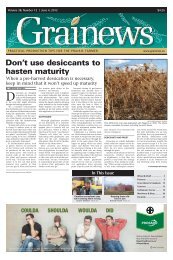MARKETING
MARKETING
MARKETING
You also want an ePaper? Increase the reach of your titles
YUMPU automatically turns print PDFs into web optimized ePapers that Google loves.
Monitor bins by<br />
sMartphone<br />
By Maggie Van Camp,<br />
CG Associate Editor<br />
A<br />
new web-based bin-monitoring<br />
system that can be accessed by<br />
smartphones is now on the market. Calgary’s<br />
Mifarm.ag Management’s system<br />
uploads real-time data on grain bin<br />
conditions to a cellular network, to help<br />
farmers better protect their crops from<br />
spoilage and theft. Sensors located in<br />
bins monitor grain volume, temperature,<br />
and relative humidity, as well as<br />
control fans.<br />
The system also uniquely monitors<br />
grain levels to warn of theft, an increasing<br />
threat.<br />
Instead of buying and installing the<br />
system, you sign up for a three-year<br />
contract and Mifarm provides the service,<br />
including the cables and relay system.<br />
This costs about $0.12 per bushel<br />
over three years and includes service.<br />
Every 15 minutes the sensors give a<br />
reading and within 10 minutes you get<br />
an alarm by email.<br />
Mifarm president, Gary Gunthorpe,<br />
says the company started installing systems<br />
this summer and recently installed<br />
a 400-sensor system in a 30-bin storage<br />
facility. The information is communicated<br />
by cloud-based database that<br />
farmers can access via web portal and<br />
smartphone applications on both Rogers<br />
and Bell. “Our cellphone modem is<br />
higher and more powerful,” said Gunthorpe<br />
when asked about cellular dead<br />
zones. “It has four times the power of<br />
your cellphone.”<br />
The development work started in<br />
September 2010 with three partners.<br />
Delta T Engineering, ATI Agritronics Inc.<br />
an instrumentation company from Saskatoon<br />
and Cervus Equipment, a large<br />
publicly traded company owning the<br />
largest group of John Deere dealers in<br />
Canada. Recently, the federal government<br />
loaned $750,000 to Mifarm.ag<br />
Management Inc. to help commercialize<br />
this grain management technology. The<br />
project forecasts the manufacturing and<br />
installation of 300 systems in 2013 and<br />
thousands more by 2016, and will create<br />
15 full-time positions in the process.<br />
Continued from page 23<br />
b u s i n e s s<br />
Grain bags have also been a good<br />
solution for larger-than-expected yields,<br />
or for crops that require storage but are<br />
only grown once in a three- or four-year<br />
rotation, like oats.<br />
In 1997, the Sheas put up two more<br />
9,000-bushel bins, enough for 100 acres<br />
of wheat or 200 acres of soybeans, the<br />
two crops that are traditional on this<br />
flat, heavy-clay land. Having three bins,<br />
naturally let them consider a third crop,<br />
and they started growing corn.<br />
That same year, Jeff came home<br />
from attending DuPont’s Young Leaders<br />
program in the Midwest with one<br />
word on his lips — ethanol. From listening<br />
to other participants, he knew<br />
corn demand was going up. He could<br />
also see yields going up, thanks to bio-<br />
AdvAntAge #2<br />
Avoid harvest marketing<br />
Over the years, Jeff has used his storage<br />
to avoid selling off the combine<br />
when harvest-time supplies<br />
were strong. His first lesson in the power<br />
of patience came with his first bin. At harvest<br />
some of his wheat graded as feed with<br />
greater than 10 per cent sprouting (another<br />
challenge in Ontario’s damp climate). Jeff<br />
stored that wheat until the end of the winter<br />
when he knew supplies were tighter… and<br />
the same wheat graded #2 with a healthy<br />
premium over feed.<br />
A few sales like that can help pay for<br />
the bin, Jeff says.<br />
Jeff leverages his stubborn streak with<br />
some good market information. In 2003<br />
the Sheas added 50,000 bushels storage<br />
and at the next harvest corn was only<br />
$2.80 a bushel. Jeff filled the bins and<br />
held… and held… and held. By September<br />
corn finally got to his sell point of $4.<br />
It’s during market downtimes when<br />
having bin space really pays, says Jeff.<br />
When prices dipped two years ago, the<br />
Sheas built a 60,000-bushel bin. “In the<br />
summer of 2010, I still had 90 per cent<br />
of 09’s corn stored, and then in August I<br />
bought all our 2011 fertilizer,” says Jeff.<br />
“Corn was $3.75 per bushel in the fall<br />
and by June it was $4.40.”<br />
However, Jeff adds that it doesn’t<br />
always work to his advantage.“Sometimes<br />
my dad says I’m too in love with the<br />
grain…”<br />
tech traits including glyphosate tolerance.<br />
Although corn prices at the time<br />
were far from stellar, Jeff saw long-term<br />
opportunity.<br />
It was an insight that was bolstered<br />
by his work as a DeKalb seed dealer<br />
and former Monsanto sales representative,<br />
where he could see exceptional<br />
corn growers in his area starting to really<br />
make progress with corn.<br />
That’s when Jeff added the dryer.<br />
“When times are tough is when I<br />
build bins,” says Jeff. “These bins are<br />
built for $3 corn, not $6 corn.”<br />
In fact, Jeff doesn’t like the risk of<br />
storing corn when prices are high and the<br />
threat of prices going down weighs heavily.<br />
Although the Sheas core all their bins<br />
and have heat cables, he’s also well aware<br />
of the potential of spoilage.<br />
A major player in Ontario’s grain sector<br />
agrees that marketing from on-farm<br />
bins takes judgment.<br />
Anyone who operates grain-handling<br />
facilities needs to clearly understand their<br />
costs and know that storing grain will<br />
not always be a good marketing strategy,<br />
says Wes Thompson, president of<br />
Thompsons Limited in Blenheim, Ont.<br />
“Get either of these principles wrong,<br />
and profits evaporate.”<br />
Commercial elevators use storage for<br />
their own account only after careful analysis,<br />
says Thompson. “Generally, one in<br />
four years, storage is a waste of money.”<br />
In 2010, storing grain for a sale later<br />
in the year was clearly a winning strategy,<br />
but in 2011, storage looked like a mistake<br />
by the end of the winter, although<br />
the Midwest drought later turned that<br />
situation completely around.<br />
The lesson, says Thompson, is that<br />
it can be hard to predict the returns to<br />
storage, and it’s impossible to guarantee<br />
that storage will pay for itself in any<br />
given year.<br />
For wheat, Tjaden Lepp also takes a<br />
cautious approach, recommending partial<br />
sales and then holding some crop<br />
for sales into early 2013. “Some pricing<br />
before harvest is a good risk management<br />
strategy,” says Tjaden Lepp.<br />
Continued on page 26<br />
2 4 c o u n t r y - g u i d e . c a S E p T E M B E R 1 7 , 2 0 1 2
















